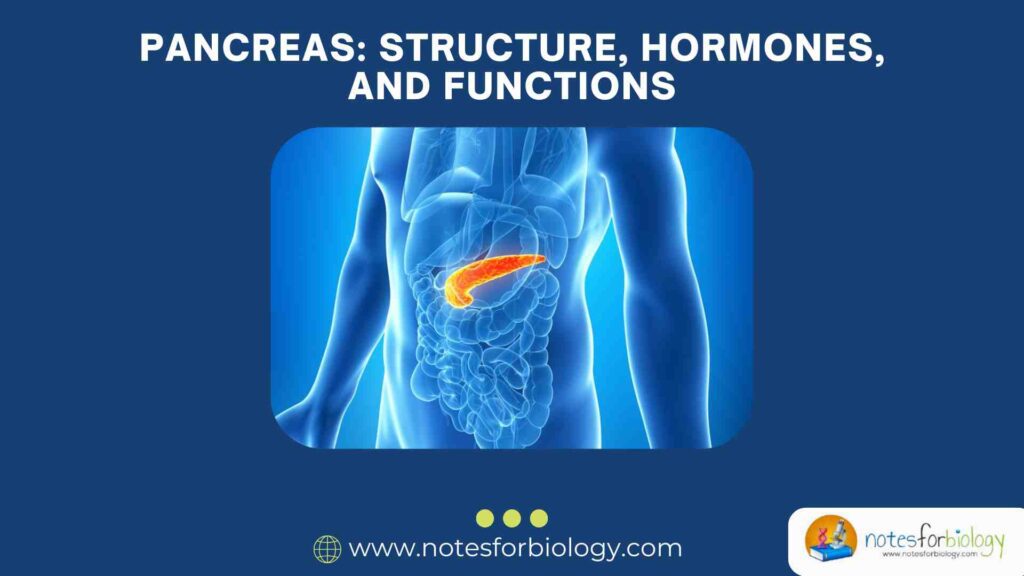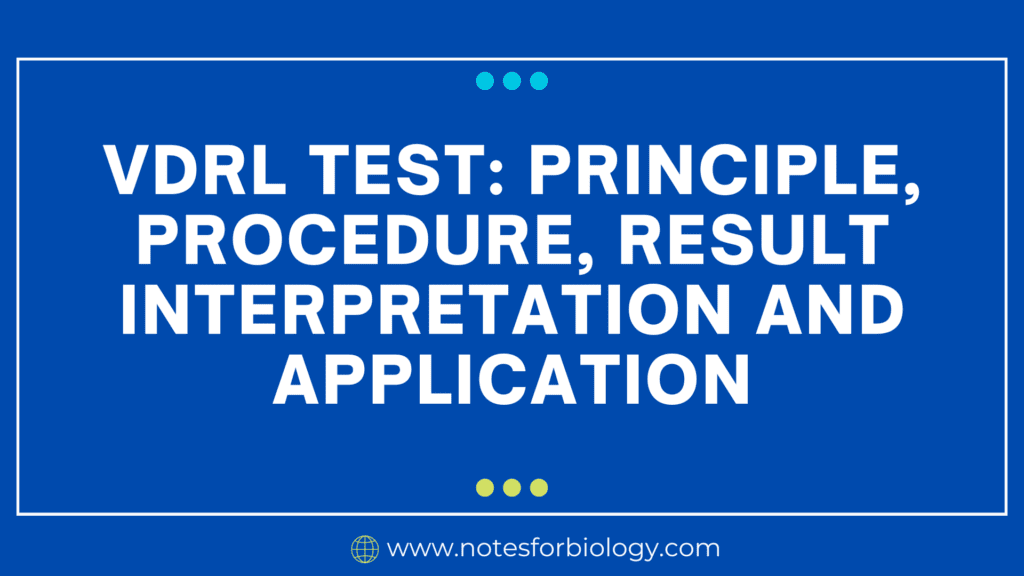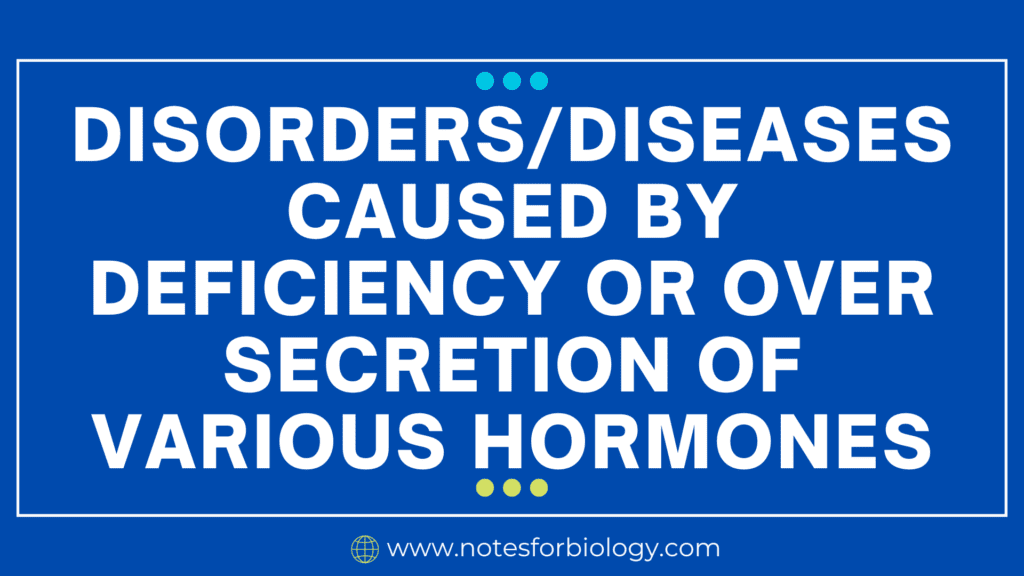1. Introduction to the Pancreas
The pancreas is a vital organ in our body that does two important jobs — it helps us digest food and control our blood sugar. It is part of both the digestive system and the endocrine system.

Although small and soft, the pancreas plays a big role in keeping us healthy. Without it, our body wouldn’t be able to absorb nutrients properly or maintain energy balance.
Let’s explore the structure, hormones, and functions of this wonderful organ.
Table of Contents
2. Structure of the Pancreas

Location and Shape
- The pancreas is a long, flat organ located in the abdomen, behind the stomach.
- It lies between the duodenum (the first part of the small intestine) and the spleen.
- It is shaped somewhat like a leaf or fish, with three main parts:
- Head – the widest part, nestled in the curve of the duodenum.
- Body – the central section, lying behind the stomach.
- Tail – the narrow end near the spleen.
Internal Structure
It has two main parts based on function:
- Exocrine Part
- Makes up about 95% of the pancreas.
- It produces digestive enzymes that help break down food in the small intestine.
- The enzymes are released through a network of small ducts into the main pancreatic duct, which joins the bile duct and opens into the duodenum.
- Endocrine Part
- Makes up about 5% of the pancreas.
- It is made of tiny clusters of cells called Islets of Langerhans.
- These cells release hormones directly into the bloodstream.
3. Hormones of the Pancreas
The endocrine part of the pancreas produces several hormones that are essential for maintaining blood sugar balance and metabolism. These hormones are made by different types of cells in the Islets of Langerhans.

Main Pancreatic Hormones:
1. Insulin
- Produced by: Beta cells
- Function: Lowers blood sugar by helping cells absorb glucose from the blood.
- Role: Stores excess glucose as glycogen in the liver or fat in fat tissues.
2. Glucagon
- Produced by: Alpha cells
- Function: Raises blood sugar by breaking down glycogen stored in the liver into glucose.
- Role: Prevents blood sugar from dropping too low, especially between meals.
3. Somatostatin
- Produced by: Delta cells
- Function: Controls or slows down the release of insulin and glucagon.
- Role: Maintains a balance between hormone actions.
4. Pancreatic Polypeptide
- Produced by: PP cells (F cells)
- Function: Regulates the secretion of digestive enzymes and affects appetite and gut movement.
5. Ghrelin (small amount)
- Produced by: Epsilon cells
- Function: Stimulates hunger; also known as the “hunger hormone.”
4. Functions of the Pancreas
It plays a dual role in the body:
A. Exocrine Function (Digestive Role)
It helps in digestion by producing enzymes that break down food in the small intestine. These enzymes are made in the exocrine cells and travel through the pancreatic duct to the duodenum.
Major Digestive Enzymes:
- Amylase – breaks down carbohydrates (like bread and rice).
- Lipase – breaks down fats (like oil and butter).
- Trypsin and Chymotrypsin – break down proteins (like meat and eggs).
- Nucleases – break down DNA and RNA.
These enzymes work best in the small intestine when mixed with bile from the liver.
B. Endocrine Function (Hormonal Role)
It keeps blood sugar levels within a healthy range by releasing hormones into the blood.
How it works:
- After a meal, blood sugar rises → Insulin is released to lower it.
- Between meals or during fasting, blood sugar drops → Glucagon is released to raise it.
This balancing act ensures the body always has enough energy without allowing sugar to rise too high (hyperglycemia) or fall too low (hypoglycemia).
5. Disorders Related to the Pancreas
When it doesn’t work properly, it can lead to serious health issues. Here are the most common problems:
1. Diabetes Mellitus
Type 1 Diabetes
- Caused by the destruction of beta cells, so the pancreas produces little or no insulin.
- Usually starts in childhood or adolescence.
- Requires daily insulin injections.
Type 2 Diabetes
- Body cells become resistant to insulin or pancreas doesn’t produce enough insulin.
- Often linked to obesity, poor diet, and lack of exercise.
- Can be managed by diet, exercise, and medications.
2. Pancreatitis
- Inflammation of the pancreas.
- Can be acute (sudden) or chronic (long-term).
- Caused by alcohol abuse, gallstones, or infections.
- Symptoms include severe abdominal pain, nausea, and vomiting.
3. Pancreatic Cancer
- A deadly form of cancer that affects the cells of the pancreas.
- Symptoms may include weight loss, jaundice, and abdominal pain.
- Often hard to detect early.
4. Cystic Fibrosis
- A genetic disorder where thick mucus blocks the pancreatic ducts.
- Prevents enzymes from reaching the intestine, causing poor digestion and nutrient absorption.
6. Summary of Key Points
| Feature | Details |
|---|---|
| Location | Behind stomach, near duodenum |
| Two main functions | Exocrine (digestive enzymes) and Endocrine (hormones) |
| Digestive enzymes | Amylase, Lipase, Trypsin, Chymotrypsin |
| Main hormones | Insulin, Glucagon, Somatostatin, Pancreatic Polypeptide |
| Major disorders | Diabetes, Pancreatitis, Pancreatic Cancer, Cystic Fibrosis |
| Importance | Controls blood sugar, helps digest food |
7. Conclusion
The pancreas is one of the most important organs in the human body, silently working every day to digest our food and regulate our blood sugar. It acts as both a gland and an organ, carrying out two entirely different functions with precision and balance.
Understanding how it works helps us appreciate how vital good nutrition, exercise, and regular health checkups are in preventing serious diseases like diabetes and pancreatitis. Taking care of your pancreas means supporting your entire body’s well-being.
FREQUENTLY ASKED QUESTIONS
What is the main function of the pancreas?
It has two main functions:
It produces digestive enzymes (exocrine function) that help break down food in the small intestine.
It releases hormones like insulin and glucagon (endocrine function) to regulate blood sugar levels.
What happens when the pancreas does not produce enough insulin?
When the pancreas does not produce enough insulin, glucose (sugar) stays in the blood instead of entering cells. This causes high blood sugar levels, which can lead to diabetes mellitus, especially Type 1 diabetes.
How does the pancreas help in digestion?
The pancreas produces enzymes such as amylase, lipase, and proteases that break down carbohydrates, fats, and proteins. These enzymes are released into the duodenum, where they help digest food so the body can absorb nutrients effectively.
Related Articles




